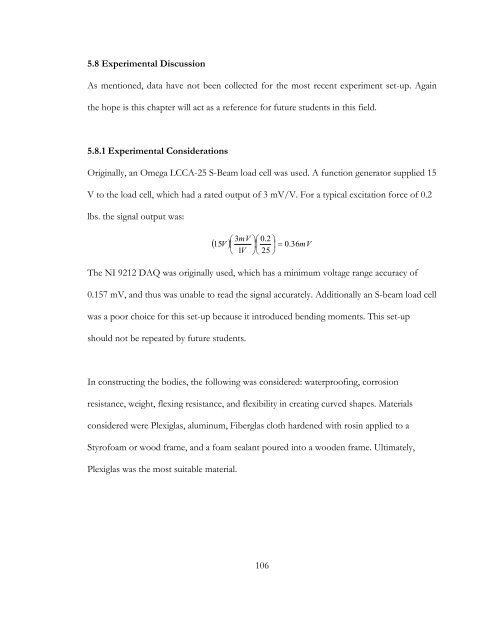MS Thesis R. Hager - Hawaii National Marine Renewable Energy ...
MS Thesis R. Hager - Hawaii National Marine Renewable Energy ... MS Thesis R. Hager - Hawaii National Marine Renewable Energy ...
5.8 Experimental DiscussionAs mentioned, data have not been collected for the most recent experiment set-up. Againthe hope is this chapter will act as a reference for future students in this field.5.8.1 Experimental ConsiderationsOriginally, an Omega LCCA-25 S-Beam load cell was used. A function generator supplied 15V to the load cell, which had a rated output of 3 mV/V. For a typical excitation force of 0.2lbs. the signal output was: 3mV0.2 1V25 15V 0. 36mVThe NI 9212 DAQ was originally used, which has a minimum voltage range accuracy of0.157 mV, and thus was unable to read the signal accurately. Additionally an S-beam load cellwas a poor choice for this set-up because it introduced bending moments. This set-upshould not be repeated by future students.In constructing the bodies, the following was considered: waterproofing, corrosionresistance, weight, flexing resistance, and flexibility in creating curved shapes. Materialsconsidered were Plexiglas, aluminum, Fiberglas cloth hardened with rosin applied to aStyrofoam or wood frame, and a foam sealant poured into a wooden frame. Ultimately,Plexiglas was the most suitable material.106
During experimentation, three types of beaches were used to dampen wave reflection fromthe end of the wave flume: a sand beach, a Plexiglas sheet with a 1:10 slope, and foam waveabsorber. The foam wave absorber has performed the best as expected.5.8.2 Environmental Sources of ErrorTo detect the effects of geometry on maximum power absorption efficiency the body mustspan a significant portion of the wavelength. With the body dimensions introduced inChapter 5.5 periods greater than 1 sec are too long to detect the body’s shape. However,linear theory pertains to waves where H
- Page 56 and 57: 4.2 AQWA Modeling ProcedureThe user
- Page 58 and 59: : Local data has changed, and the c
- Page 60 and 61: Figure 4. 5 Drawing in Design Modul
- Page 62 and 63: 12. Delete all lines inside the cur
- Page 64 and 65: 22. Edit the details of the slice u
- Page 66 and 67: Figure 4. 15 Details of the Part7.
- Page 68 and 69: Figure 4. 17 Details of the Mesh4.2
- Page 70 and 71: Figure 4. 21 Detials of the Wave Di
- Page 72 and 73: 5. Highlight Diffraction + Froude-K
- Page 74 and 75: Table 4.1 Body Dimensions for Numer
- Page 76 and 77: concavity from concave down to conc
- Page 78 and 79: Figure 4. 29 Maximum Power Absorpti
- Page 80 and 81: Table 4. 3 Numerical ResultsBodyNo.
- Page 82 and 83: BodyNo.Bodyλ atT=2.1λ atT=1.0λ a
- Page 84 and 85: WAVEFigure 5. 1 Body Faces Wave Mak
- Page 86 and 87: The body connects to the aluminum p
- Page 88 and 89: also allowed for flexibility in cre
- Page 90 and 91: AB1 23 4 5 6 7CD8 9 10 11EFigure 5.
- Page 92 and 93: and minimum voltage range of the DA
- Page 94 and 95: Figure 5. 11 Deleting a Step from L
- Page 96 and 97: Figure 5. 14 Recording Options, Sig
- Page 98 and 99: Figure 5. 17 Right-mouse Click on t
- Page 100 and 101: Zero-OffsetThe Zero-Offset step rem
- Page 102 and 103: Figure 5. 24 Filter Step Set-up, Co
- Page 104 and 105: 5.6 Data ProcessingFigure 5. 26 Wav
- Page 108 and 109: 5.8.3 Suggestions for Future Resear
- Page 110 and 111: 110ikxxRekddzkgkn )cosh())(cosh(,
- Page 112 and 113: Proof M ij and B ij are Symmetric T
- Page 114 and 115: BIBILIOGRAPHYANSYS. (n.d.). ANSYS A
- Page 116: Trust, C. (2011). Capital, Operatin
5.8 Experimental DiscussionAs mentioned, data have not been collected for the most recent experiment set-up. Againthe hope is this chapter will act as a reference for future students in this field.5.8.1 Experimental ConsiderationsOriginally, an Omega LCCA-25 S-Beam load cell was used. A function generator supplied 15V to the load cell, which had a rated output of 3 mV/V. For a typical excitation force of 0.2lbs. the signal output was: 3mV0.2 1V25 15V 0. 36mVThe NI 9212 DAQ was originally used, which has a minimum voltage range accuracy of0.157 mV, and thus was unable to read the signal accurately. Additionally an S-beam load cellwas a poor choice for this set-up because it introduced bending moments. This set-upshould not be repeated by future students.In constructing the bodies, the following was considered: waterproofing, corrosionresistance, weight, flexing resistance, and flexibility in creating curved shapes. Materialsconsidered were Plexiglas, aluminum, Fiberglas cloth hardened with rosin applied to aStyrofoam or wood frame, and a foam sealant poured into a wooden frame. Ultimately,Plexiglas was the most suitable material.106



